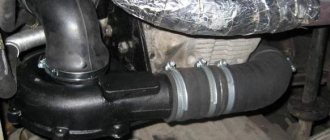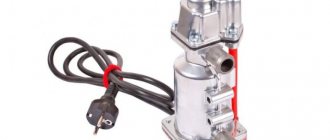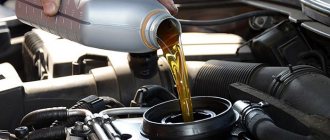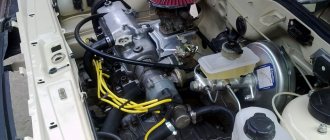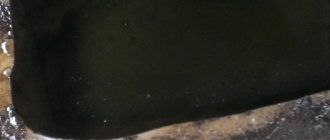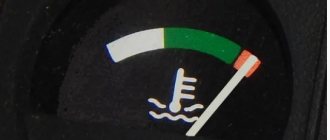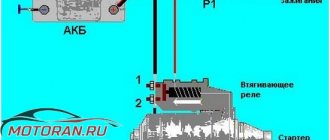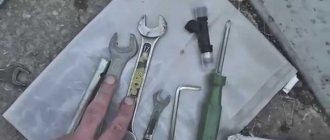Effective engine flushing. Engine cleaning methods that actually work
How to keep the engine lubrication system clean for many years. After all, this factor is one of the most important for the health of the engine when operating a car. Why is this needed, let's figure it out. Sludge, slag, carbon are all the result of the combustion process in the engine. When we buy a car, due to lack of time, money, etc., we simply forget about proper car maintenance. And this drags on for a long time, during which sediment in the form of combustion products settles on the engine parts. Due to this, their friction increases - metal on metal, and destruction occurs accordingly.
The oil filter does not always cope with its task and microparticles that do not fall under the filter begin to circulate in the engine, causing microscopic scratches and damage to the cylinder walls and bearings. Valves begin to stick, hydraulic compensators knock, the operation of the pistons is disrupted, causing engine vibrations. Then the car owner wonders why the engine consumes liters of oil per 1000 km. Where does such high fuel consumption come from? Here is the result of the car owner's inaction, see the picture below. This motor has not even completed 30,000 km. Look at the condition it's in.
Why flush the engine?
What should I do, you ask?! You don’t have to do anything, you just have to wash it, that’s all. Many people are skeptical about engine flushing, for good reason. A lot of junk has appeared on the market, supposedly washing products that contain an ultra-high solvent and are in no way suitable for the engine. Don't pay attention to cheap washes.
DO NOT grab the first one you see off the store shelf. A good flush is a product that will restore compression in the engine cylinders, effectively remove sludge and dirt, and not only allow it to fall off, but also dissolve it, so that it does not clog the channels and is easily removed from the mixture system. Also, a good flush should cover all microscopic defects in the engine, and restore both the oil seals and all rubber seals.
How much does flushing oil cost and which one to choose?
There are a large number of engine cleaning solutions available on the market today. Each manufacturer strives to attract customers by promising cleanliness and the absence of harmful effects of flushing on the engine and its parts, as well as on fresh oil after filling.
It should be understood that any cleaning composition contains packages of alkaline detergents and other additives. One way or another, such additives affect the properties of rubber products. Now let's look at some of the most popular and common suggestions from the list of quick flushes and flushing oils.
- Liqui Moly quick flush allows you to effectively clean the lubrication system of the power unit, occupying a leading position in the ratings of the best flushing oils and detergent additives. It removes accumulated deposits well, washes channel walls and surfaces of parts. The average cost is about 20 USD.
- ZIC flushing oil ensures high-quality engine cleaning. Fairly safe for seals and other sealing parts. Does not contribute to the oxidation of fresh motor oil in the internal combustion engine. A canister of such washing costs about 15 USD.
- The Eneos product not only has outstanding cleaning properties, but also prevents clogging of the oil system channels. The composition is capable of retaining contaminants and impurities in the form of a suspension. A container with 4 liters of such oil will cost about 22 USD.
We also recommend reading the article about how to flush the engine with diesel fuel before changing the oil. From this article you will learn about the features of this method of cleaning the oil system, as well as how to rinse the engine with diesel fuel correctly.
- Among domestically produced flushing oils, Lukoil should be highlighted. The solution has an affordable price and cleans the power unit well. The composition uses a rich package of additives that provide anti-wear properties and quickly dissolve all kinds of contaminants. The price for such washing is about 14 USD.
- Another well-known product is Rosneft flushing oil. The flushing composition is mineral oil, which additionally contains detergent additives that are safe for gaskets and seals. It qualitatively dissolves sludge carbon deposits and removes various deposits from the lubrication system. Flushing can be used in both gasoline and diesel internal combustion engines to remove dirt and for preventive cleaning. The price is at the average level of about 15 USD.
- TNK flushing oil also deserves attention. The Promo Express product is a popular solution and is actively used in technical stations. The solution is a successful combination of effective cleaning properties at an affordable price. The average cost is about 13 USD.
As you can see, imported compounds are often almost twice as expensive as domestic products. At the same time, the cleaning properties are at approximately the same level. With regard to the impact on seals, oil seals and gaskets, practical operation shows some advantage of foreign solutions (especially Liqui Moly, Shell, ZIC and Eneos) compared to other flushing oils.
Methods for cleaning a car engine
Let's look at several ways to effectively clean the engine of carbon deposits and sludge.
1.
In spare parts stores you can find a product such as, for example, motor oil with a viscosity of SAE 40. This is a seasonal summer product that has a fairly high cleaning power and effectively cleans the engine.
Drain the used engine oil and refill with this oil without changing the oil filter. Start the engine and idle for about 15-30 minutes, you can take it for a ride a little. Then drain the oil, most likely it will be black, as it will collect all the dirt that has collected on the walls, parts, etc. Repeat everything done previously until the color of the oil is the same as you poured it.
This is one of the best ways to flush the engine, and after the clean oil is drained, you will be sure that the engine is clean. Result.
After this method of flushing the engine of a problematic 1992 Ford Explorer, oil and fuel consumption decreased, the engine began to run quieter, the car became smoother and more responsive.
2.
The second way is to wash the engine well. Flushing from Liqui Moly Engine flush is popular among the common people and has long deserved recognition. It is poured into the engine with used oil, the engine warms up for about 10 minutes and then drained. Excellent product, easy to use, and most importantly effective.
Always take it as a consumable when changing engine oil. Long-term flushing is also suitable here if everything is really bad.
Fill it up 300 km away. before the shift, the cleaning will already begin.
Lambda Oil Primer.
Here is another interesting and super effective thing for flushing a car engine - Lambda Oil Primer.
This product is approved by TUV, ROHS and VAG. Works well in restoring engine compression. Many who used it were simply eager to do a compression test before and after use. The results were great after washing. Ideal cleanliness and operation of the motor, as well as its subsequent protection. Used in gasoline and diesel engines. One of the best premium washes in the world.
As for the product characteristics:
Effectively cleans the oil lubrication system, preventing problems associated with the accumulation of sludge, dirt, and deposits. After cleaning, clean oil in a clean engine is guaranteed for many kilometers. It is used both in the engine and in gearboxes and differentials. Contains a lubricant that protects mechanical parts during the cleaning process. Suitable for all types of modern and old gasoline engines. and design engines. added to any motor oil.
When changing the oil, many car enthusiasts resort to flushing the oil system. The operation of the engine is delicate and has its own nuances, which should be known to anyone who is going to do it on their own.
Engine flushing requirements
When is it necessary to flush the engine? As a rule, experts recommend doing this work in the following cases:
- When filling in a lubricant from another manufacturer or brand of motor oil;
- when changing viscosity or type (for example, when instead of “mineral water” you fill in “synthetic” or vice versa);
- if there is a suspicion that low quality fuel or antifreeze has entered the power unit. In addition, flushing the engine is mandatory if you accidentally pour low-quality oil or a completely different composition into the neck;
- if there are doubts about the timing of the last replacement (for example, when buying a car second-hand);
- after any repair work on the engine related to the repair of the cylinder head. This is explained by the fact that during repairs there is a high probability of various “garbage” getting into the oil.
Thus, the question of the importance, benefit or danger of flushing the power unit after using old oil remains open. Both options (with and without flushing) have their own characteristics, pros and cons.
Here, every car enthusiast must figure out for himself how clogged the engine is, when the last oil change was made, what type of lubricant was used, and which one needs to be filled.
At the same time, you must understand what risks exist for the engine in a given case. Good luck on the roads and of course no breakdowns.
General view of the VAZ 2107 car engine
To increase the service life of the engine of a VAZ 2107 car, it is necessary to monitor the serviceability of its parts. Good lubrication is one of the criteria for keeping the unit in working order.
Factors influencing oil change intervals:
- Vehicle service life.
- Engine condition.
- The manner of its operation.
- Driving seasons.
- Brand of motor oil used.
- Intensity of vehicle use.
- Fuel quality.
- The service life of the engine can be reduced already during the period of improper running-in of the machine. You need to drive calmly, make sure not to overheat the engine, use only good quality oil for filling.
- An owner who has recently purchased a car should know that on a VAZ 21074, changing the engine oil can be carried out according to the recommendations given by the manufacturer.
- A different approach requires an older car. Immediately after purchasing it, you need to change the oil in the VAZ 21074 engine. You need to drain the old oil, wash the engine, fill in another, high-quality one, and install a new filter.
Flushing the engine oil system: when needed
So, antifreeze or antifreeze can get into the lubrication system for various reasons, but the most common culprit is damage. Rarely formed. In any case, the result of mixing oil and coolant is an emulsion.
This phenomenon is very dangerous for the motor, since the lubricant loses its properties, wear and tear of other elements and components in the engine increases significantly. Moreover, water and ethylene glycol, mixed in certain proportions and, in fact, representing coolant, after entering the oil, cause coagulation of various contaminants.
Simply put, dirt in the lubrication system literally sticks together. Additives in oil and antifreeze react after mixing and quickly decompose, the oil immediately oxidizes, etc. Large “lumps” consisting of deposits can even clog the oil receiver mesh filter, as a result it begins.
It is important to take into account that, for example, after replacing the cylinder head gasket, it will not be possible to completely drain the waste from the engine. This means that if you fill in a new portion of fresh lubricant, the lubricant will also mix with the remaining emulsion, and unwanted deposits will still form in the oil channels and on the internal surfaces of the engine.
If the engine is not additionally flushed, this situation will repeat for at least 2-3 more replacements. We also note that similar recommendations also apply when, for some reason, the oil change interval was violated (for example, the lubricant was replaced not after 10 thousand km, but after 15 thousand). Also, flushing is recommended if necessary, adding oil from a third-party manufacturer, when necessary, etc.
At the same time, flushing the engine may be necessary if the owner purchased a used car, and the service history of a particular car is unknown or questioned. It often happens that after changing the oil on such a car (literally after 50-100 km).
Finally, it is also worth highlighting the possible filling of low-grade oil into the engine. Among motor oils, unfortunately, . Naturally, after discovering this fact, you need to remove the surrogate from the internal combustion engine, then the engine must be flushed.
A counterfeit product is usually indicated by strong and rapid blackening of the lubricant, an unpleasant pungent odor, the appearance of a black coating under the valve covers, cloudiness of the oil, a significant change in its viscosity for no obvious reason, an increase in lubricant consumption, etc.
Why is flushing necessary?
Failure to flush the cooling system in a timely manner can lead to the radiator becoming clogged over time. Refrigerant wear products, corrosive residues, scale that appears as a result of using water instead of antifreeze - sooner or later this will contribute to a decrease in the performance of the radiator.
Failure of this element will result in problems with the operation of the engine, which, of course, will affect the functioning of the car as a whole. So flushing the engine cooling system is a process that should not be neglected, at least in order to protect your radiator. The procedure should be carried out at least once every two years, and the recommendations of the car manufacturer should be taken into account. By observing this frequency, you can prevent the formation of refrigerant wear and corrosion in the system.
How to flush the engine from emulsion, dirt and deposits
It is quite obvious that if you need to wash the engine from the inside, then you need a good engine flush. There are a large number of different formulations on sale.
In practice, all products can be divided into two groups:
- additives for mining;
However, choosing the best engine flush product is not so easy. First of all, you need to proceed from the specific situation. If you just need to flush the lubrication system before changing the oil, and we are not talking about removing remnants of an emulsion or counterfeit product, then a regular “five-minute” may be quite enough.
The only thing is that this method should be used with caution on old engines. The fact is that over long runs the unit will definitely be dirty, while the “five-minute” ones are very aggressive and separate accumulated deposits in the pan, but do not dissolve them. Such deposits may well clog the oil receiver with all the ensuing consequences.
It should also be remembered that quick flushes in oil can also have a negative effect on gaskets, seals and other seals. There have been cases where, after applying oil flushes, the engine began to leak.
- In case of more serious contamination, it is better to use ready-made flushing oils, which are poured into the engine in full instead of base oil. Depending on the type of flushing composition, the unit should either operate only at idle speed, or short-term driving with minimal loads on the internal combustion engine is allowed.
This type of washing is less aggressive to rubber seals compared to “five-minute” ones, and also more thoroughly washes away dirt and deposits. We also note that flushing oils can be synthetic, semi-synthetic or mineral, and are also universal. In other words, they can be used in both gasoline and .
At the same time, the risk of “clogging” the channels and filters (for example, in the oil receiver mesh) with soggy dirt is still present, but it is not so high compared to a quick rinse in engine oil.
First of all, before adding new lubricant, it is important to thoroughly remove old oil from the engine. In other words, you need to try to drain as much as possible.
Also, after flushing the engine, if possible, you should get rid of as much of the flushing oil as possible, so that a minimum amount of residue is mixed with fresh lubricant.
To do this, it is better to drive the car a little, warming up the engine while driving. Only after this is the car installed horizontally on a flat surface, then the drain plug is unscrewed. By the way, the lubricant should drain by gravity. It is not recommended to use other methods of draining and pumping out oil (for example, vacuum suction through the oil filler neck, etc.).
We also note that even before starting flushing, regardless of the flushing agent, it is necessary. As part of the flushing, you can install the simplest and cheapest one.
If this is not done, the flushing composition will dissolve the dirt in the old filter, and then loose deposits from other areas will be added to this. As a result, the filter capacity will be greatly reduced, the bypass valve will open and contaminants can flow back into the engine.
Having decided what you can use to flush the engine when changing the oil, it is important to understand that before using flushing oil or “five-minute washes” you need to carefully study the instructions. It is strongly recommended to follow all instructions from the manufacturer of a particular formulation.
Also, the flushing should not be left in the engine, load the engine while driving on flushing oil, accelerating at idle or using quick flushes into the oil, etc. Also, after using flushing fluids and adding fresh oil, it is better to reduce the interval for its subsequent replacement by 30-50%.
This approach eliminates the possibility of increased wear of the internal combustion engine as a result of the loss of the beneficial properties of the new oil after contact with the remnants of a previously used flush.
Flushing Recommendations
Today in our car stores you can find many different products and liquids for flushing the cooling system. Many car enthusiasts mistakenly believe that the best option is to use distilled water, but this is far from the case. Ordinary liquid contains a large amount of salts, which, as a result of washing, form scale on the internal walls of the system elements.
Special equipment
The range of specialized cleaning products is quite huge - liquids with different compositions and concentrations can be found on sale. However, you need to pay attention to the choice of cleanser, since different products should be used to remove different types of contaminants. In general, such liquids are divided into several types:
- Neutral products contain no aggressive elements. It is better to use such products for preventive purposes, since they are not very effective for flushing directly.
- The composition of acid additives is very aggressive, so they are not sold in their pure form. Usually used by specialists to remove scale from the cooling system.
- Alkaline products have an aggressive composition and are designed to remove organic formations.
- In the case of two-element products containing alkali and acid, flushing allows you to remove almost all types of contaminants from the cooling system.
Experts do not recommend using several types of liquids at the same time because alkali and acid can be neutralized by each other when interacting. Accordingly, this will not bring the desired result. We also do not recommend using too concentrated products, as this may cause the liquid to corrode the rubber and plastic components of the system.
Traditional methods
Cleaning the cooling system with citric acid is an old flushing method that has been used by domestic motorists for decades. If the proportions are correct, then citric acid will allow you to optimally remove scale from the radiator, without negatively affecting rubber and plastic. According to experienced motorists, you will need about 100 grams of citric acid per 1 liter of distillate. But keep in mind that no one is responsible for the effectiveness of the method, so all responsibility falls on you.
Car enthusiasts also practice using regular cleaning serum instead of citric acid. According to those who practice this method regularly, the composition of the serum allows for effective and, importantly, gentle flushing of the car’s cooling system. As in the previous case, the serum will not destroy rubber and plastic elements. According to experts, this procedure should be carried out in two or three short approaches - this will allow the system to be flushed most effectively.
"Coca Cola"
There are different opinions among our car enthusiasts about Coca-Cola. One claims that thanks to aggressive components, such as phosphoric acid, included in the drink, Coca-Cola can effectively remove all dirt and scale from the elements of the car’s cooling system. According to others, such an aggressive drink should be used very carefully, or better not used at all, since sugar, which is in excess in the composition, will only contribute to clogging of the pipes. So if you decide to use the drink, then after it in any case you need to use the distillate again to eliminate sugar residues.
Also, the drink can damage the car due to the presence of gas in it. Since gas tends to expand when interacting with the heat of a car engine, this can cause certain problems. So in case you don't have the right products on hand to clean the system, but you have a nosebleed, you need to do it, get rid of the gas in your drink. Open it and leave it with the cap open for an hour. The longer, the more gases will come out of the bottle.
Coca-Cola for rinsing
Causes of engine oil starvation
There may be several reasons.
- There is not enough oil in the engine - the level is low, someone leaked it and did not top it up
- The oil has not been changed for a long time, it has thickened, collected in pieces on the walls of the engine and does not flow into the sump
- The oil receiver screen is clogged
- The oil filter is clogged and the bypass valve is stuck
- The oil injectors are stuck in the open position and the pressure in the system has dropped
- The pressure reducing valve on the oil pump is broken and oil flows through it into the return line.
- Oil channels clogged
- Come up with a reason yourself (if possible, write down in the comments what other reasons there may be)
1. Any engine consumes oil due to waste - some more, some less. If you don’t look under the hood and check the oil level for a long time, then at one point the oil will become so low that it will no longer reach the oil receiver. First, this will happen when the car leans over while climbing a hill, then when it turns at speed and the oil, under the influence of centrifugal force, rushes away from the oil receiver. It is, of course, small things, but gradually the oil will become less and less, but it will stop flowing to the most remote corners of the engine.
2. When the oil is not changed for a long time, some kind of thick and non-flowing fuel oil is formed in it, which likes to collect on the walls of the block and in the head. The liquid fraction is becoming less and less, and hence we look at point 1. This happens especially often on modern cars, on which the manufacturer recommends extended oil change intervals (Long Life, up to 30,000 km). And if at the service you come across not very responsible technicians who do not drain all the old oil, there will be problems. Change the oil at least once every 10,000, or better yet, more often.
3. The dung that forms in the old oil (see point 2) can clog the oil receiver screen and then the oil will stop flowing into the lubrication system. Although the grid becomes clogged for other reasons.
4. The oil filter consists of a housing and the actual paper filter element. All the smallest particles of dirt clog the pores in the paper and over time the filter's throughput is lost. To prevent oil starvation when the filter is clogged (usually this does not happen if you change the oil on time, although how much dirt gets into the engine also depends on the air filter and operating conditions on dusty roads), the filter has a bypass valve - in In the normal position it is closed, but as soon as the flow capacity is lost, the valve opens under the influence of vacuum created by the oil pump. When the valve jams, naturally the oil will not come from anywhere, and less and less oil will circulate through the lubrication system with less pressure.
5. Some engines, mostly turbocharged ones, have oil injectors that spray oil onto the pistons to cool them. The injectors open under pressure, and when there is no oil pressure in the system, they close. If the injector is faulty and opens, the pressure in the system will decrease, which means the oil will not reach remote corners of the engine. Although if you have a budget foreign car with a low-power engine, such as a Ford Focus or Chevrolet Aveo, then you should not worry - they do not have such a system
6. The oil pump has a pressure relief valve, which is designed to relieve excess pressure. If it jams, the pressure in the system will drop, especially at low speeds, which will lead to oil starvation.
7. The engine lubrication system consists of oil channels. The most vulnerable part is the crankshaft. The crankshaft has oil channels through which oil flows from the main journals to the connecting rods. These channels are very narrow and can very easily become clogged with all sorts of dirt, which will lead to oil starvation of the connecting rod bearings.
8. You can come up with some other reasons, if you missed something, write in the comments
How to wash the engine
Today, motorists use various means to wash their car's engine. Each of them has strengths and weaknesses.
- Kerosene, diesel fuel. An old grandfather's method that is still relevant today. It effectively removes contaminants, but after the first start of the engine there is dangerous smoke that can flare up at any moment. Plus you will smell bad for a long time. So the option is so-so.
- Detergents for washing dishes. They are in demand among VAZ 2114 owners, and not only for the simple reason that they efficiently break down fat, and therefore can easily cope with motor oil. But some other types of pollution become an insurmountable obstacle for them.
- Special solutions and liquids. They are sold in automotive chemical stores and are intended specifically for washing engines. As you understand, this is the most expensive, but most effective remedy that can cope with even the most complex types of contamination of the power unit. Today, the products of such manufacturers as K&W, Liqui Moly, and one domestic one - AT VNIIkhimproekt are in demand.
Some “craftsmen” use gasoline. What exactly made them use such a remedy still remains an unanswered mystery. This is the most wrong option you can think of. Gasoline is incredibly dangerous from the point of view of washing the engine, since any slightest spark can lead to a fire. Do not take risks under any circumstances and refuse such an undertaking. Precedents have already happened, and their ending was far from the most fun
.
